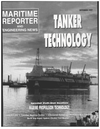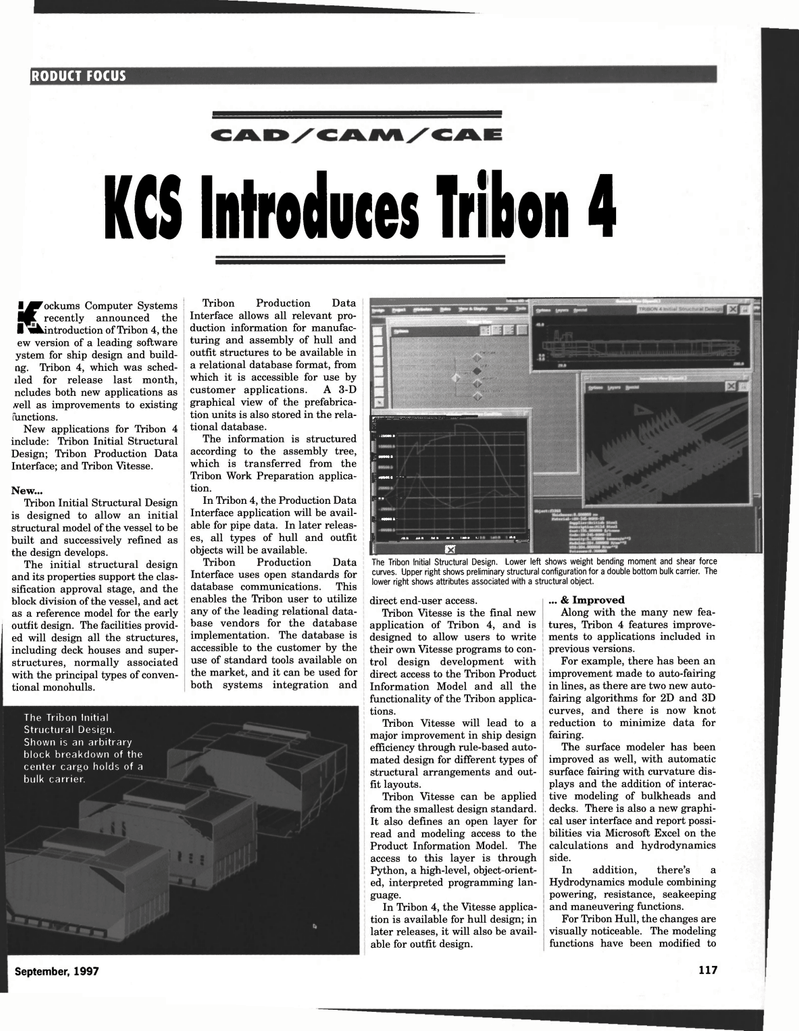
Page 117: of Maritime Reporter Magazine (September 1997)
Read this page in Pdf, Flash or Html5 edition of September 1997 Maritime Reporter Magazine
RODUCTFOCUS
KCS Introduces Tribon 4
U^Wockums Computer Systems
I^T recently announced the
I ^^introduction of Tribon 4, the ew version of a leading software ystem for ship design and build- ng. Tribon 4, which was sched- ded for release last month, ncludes both new applications as .veil as improvements to existing functions.
New applications for Tribon 4 include: Tribon Initial Structural
Design; Tribon Production Data
Interface; and Tribon Vitesse.
New...
Tribon Initial Structural Design is designed to allow an initial structural model of the vessel to be built and successively refined as the design develops.
The initial structural design and its properties support the clas- sification approval stage, and the block division of the vessel, and act as a reference model for the early outfit design. The facilities provid- ed will design all the structures, including deck houses and super- structures, normally associated with the principal types of conven- tional monohulls.
Tribon Production Data
Interface allows all relevant pro- duction information for manufac- turing and assembly of hull and outfit structures to be available in a relational database format, from which it is accessible for use by customer applications. A 3-D graphical view of the prefabrica- tion units is also stored in the rela- tional database.
The information is structured according to the assembly tree, which is transferred from the
Tribon Work Preparation applica- tion.
In Tribon 4, the Production Data
Interface application will be avail- able for pipe data. In later releas- es, all types of hull and outfit objects will be available.
Tribon Production Data
Interface uses open standards for database communications. This enables the Tribon user to utilize any of the leading relational data- base vendors for the database implementation. The database is accessible to the customer by the use of standard tools available on the market, and it can be used for both systems integration and r— - |f '»mmtv jj Mttt | | «#•« o - - -
B l""'!"'" t'i - www a - | ; j ; jj >wft m » *» * UNIt « » 1 1 E?
The Tribon Initial Structural Design. Lower left shows weight bending moment and shear force curves. Upper right shows preliminary structural configuration for a double bottom bulk carrier. The lower right shows attributes associated with a structural object. direct end-user access.
Tribon Vitesse is the final new application of Tribon 4, and is designed to allow users to write their own Vitesse programs to con- trol design development with direct access to the Tribon Product
Information Model and all the functionality of the Tribon applica- tions.
Tribon Vitesse will lead to a major improvement in ship design efficiency through rule-based auto- mated design for different types of structural arrangements and out- fit layouts.
Tribon Vitesse can be applied from the smallest design standard.
It also defines an open layer for read and modeling access to the
Product Information Model. The access to this layer is through
Python, a high-level, object-orient- ed, interpreted programming lan- guage.
In Tribon 4, the Vitesse applica- tion is available for hull design; in later releases, it will also be avail- able for outfit design. ... & Improved
Along with the many new fea- tures, Tribon 4 features improve- ments to applications included in previous versions.
For example, there has been an improvement made to auto-fairing in lines, as there are two new auto- fairing algorithms for 2D and 3D curves, and there is now knot reduction to minimize data for fairing.
The surface modeler has been improved as well, with automatic surface fairing with curvature dis- plays and the addition of interac- tive modeling of bulkheads and decks. There is also a new graphi- cal user interface and report possi- bilities via Microsoft Excel on the calculations and hydrodynamics side.
In addition, there's a
Hydrodynamics module combining powering, resistance, seakeeping and maneuvering functions.
For Tribon Hull, the changes are visually noticeable. The modeling functions have been modified to
The Tribon Initial
Structural Design.
Shown is an arbitrary block breakdown of the center cargo holds of a bulk carrier.
September, 1997 117

 116
116

 118
118
